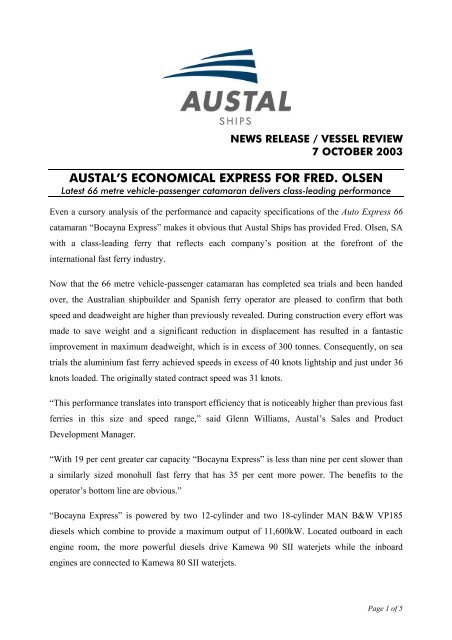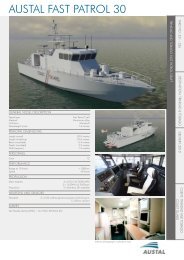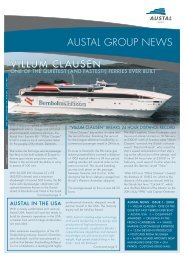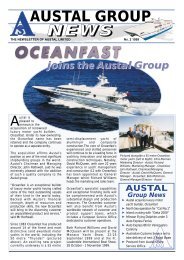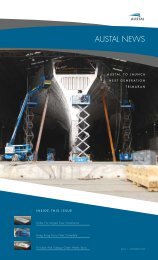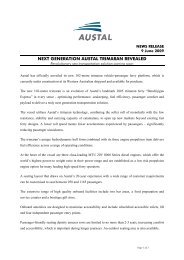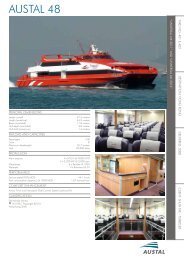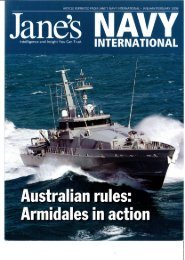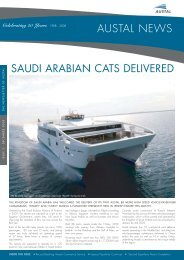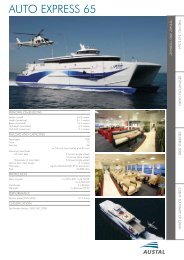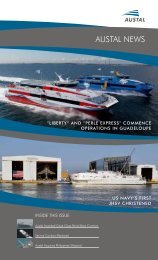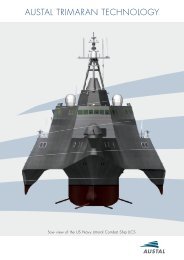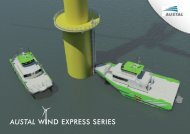austal's economical express for fred. olsen - Austal Ships
austal's economical express for fred. olsen - Austal Ships
austal's economical express for fred. olsen - Austal Ships
- No tags were found...
You also want an ePaper? Increase the reach of your titles
YUMPU automatically turns print PDFs into web optimized ePapers that Google loves.
NEWS RELEASE / VESSEL REVIEW7 OCTOBER 2003AUSTAL’S ECONOMICAL EXPRESS FOR FRED. OLSENLatest 66 metre vehicle-passenger catamaran delivers class-leading per<strong>for</strong>manceEven a cursory analysis of the per<strong>for</strong>mance and capacity specifications of the Auto Express 66catamaran “Bocayna Express” makes it obvious that <strong>Austal</strong> <strong>Ships</strong> has provided Fred. Olsen, SAwith a class-leading ferry that reflects each company’s position at the <strong>for</strong>efront of theinternational fast ferry industry.Now that the 66 metre vehicle-passenger catamaran has completed sea trials and been handedover, the Australian shipbuilder and Spanish ferry operator are pleased to confirm that bothspeed and deadweight are higher than previously revealed. During construction every ef<strong>for</strong>t wasmade to save weight and a significant reduction in displacement has resulted in a fantasticimprovement in maximum deadweight, which is in excess of 300 tonnes. Consequently, on seatrials the aluminium fast ferry achieved speeds in excess of 40 knots lightship and just under 36knots loaded. The originally stated contract speed was 31 knots.“This per<strong>for</strong>mance translates into transport efficiency that is noticeably higher than previous fastferries in this size and speed range,” said Glenn Williams, <strong>Austal</strong>’s Sales and ProductDevelopment Manager.“With 19 per cent greater car capacity “Bocayna Express” is less than nine per cent slower thana similarly sized monohull fast ferry that has 35 per cent more power. The benefits to theoperator’s bottom line are obvious.”“Bocayna Express” is powered by two 12-cylinder and two 18-cylinder MAN B&W VP185diesels which combine to provide a maximum output of 11,600kW. Located outboard in eachengine room, the more powerful diesels drive Kamewa 90 SII waterjets while the inboardengines are connected to Kamewa 80 SII waterjets.Page 1 of 5
<strong>Austal</strong> has also developed versions of the Auto Express 66 that feature more powerful engines<strong>for</strong> even higher speeds and mezzanine vehicle decks to increase capacity up to 129 cars. GlennWilliams says these variants also have significantly superior per<strong>for</strong>mance than competingmonohulls.“Under realistic loading conditions, the Auto Express 66 would be 1.5 to 2 knots faster than amonohull that has far less car capacity and more installed power. Overall that monohull will use85 per cent more fuel per car per mile while travelling slower – these figures speak <strong>for</strong>themselves.”Visiting <strong>Austal</strong>’s Henderson shipyard in the early part of September <strong>for</strong> the final trials of thevessel, Mr Fred Olsen Jnr, Executive Chairman of Fred. Olsen, SA said he was delighted withthe new addition to his fleet, which currently consists of three catamaran fast ferries and twoconventional monohulls, one of which will be replaced by “Bocayna Express”.“The new catamaran brings together the experience and expertise of both our company and<strong>Austal</strong> <strong>Ships</strong>, and the excellent results achieved in all areas reflect this. We work very hard to beable to succeed in the fast ferry business, and “Bocayna Express” gives every indication that sheis able to meet our criteria,” he said.“I am confident that both passengers and cargo operators will be very pleased with the fast,com<strong>for</strong>table and reliable service this new ship will provide. These attributes and thecomparatively low operating and ownership costs give us an advantage,” Mr Olsen explained.The 450 passenger capacity catamaran will operate across the Bocayna Strait between theislands of Lanzarote and Fuerteventura and replaces a 14 knot monohull Ro-Pax ferry. Its designwas specifically developed taking the route’s shallow waters, strong winds and physical shipsize restrictions into account. As the crossing is only nine nautical miles, Fred. Olsen, SA hasopted not to fit a full motion control system to “Bocayna Express”. While the transom-mountedinterceptors and <strong>Austal</strong> hull shape are expected to provide the necessary level of com<strong>for</strong>t,<strong>for</strong>ward T-foils can be easily installed at a later date if it is deemed necessary.The introduction of the new fast ferry will enable Fred. Olsen, SA to double the frequency of theservice. Scheduled crossing time, including manoeuvring in port, is just 20 minutes, and loadingand unloading will be completed in just 10 minutes.Page 2 of 5
Short turnaround times are facilitated by the straight<strong>for</strong>ward layout of the drive-through vehicledeck, which is open at both bow and stern to save weight and reduce construction cost. Rated <strong>for</strong>axle loads up to 12 tonnes and providing clear height of 4.2 metres, the deck can carry trucksand buses in addition to cars and motorcycles. Maximum capacity is 69 cars and there are 110lane-metres <strong>for</strong> heavy vehicles.<strong>Austal</strong> designed the Auto Express 66 so that it would seamlessly integrate with Fred. Olsen,SA’s existing terminal facilities. The ferry’s <strong>for</strong>ward vehicle ramp is designed to support theweight of both the shore ramp and the transferring vehicles and is raised and lowered using twohydraulic capstans. The arrangement at the stern is simplicity itself, with the bulwark foldingdown to allow the shore-based ramp to lock directly onto the vehicle deck.External stairs lead up to an open aft deck where 80 passengers can sit and enjoy the CanaryIslands sun, views over the stern and refreshments from the bar on the short crossing. Thepassenger deck can also be reached via internal stairs amidships or using the lift installed on thestarboard side.Once inside the cabin it is immediately apparent that passenger com<strong>for</strong>t and fitout quality havenot been sacrificed in achieving the economy and practicality that underpins the operator appealof the Auto Express 66. The floors are covered with plush wool carpet in combination with otherhigh quality flooring materials <strong>for</strong> the wide walkways and other high traffic areas. Similarlyprudent choices have been made in selecting the ceilings and aluminium honeycomb panelling.One of the cabin’s main features in terms of passenger amenities is the lounge area locatedbetween the bar aft and the shop and transverse walkway amidships. Fitted out with com<strong>for</strong>tablearmchairs arranged around circular pedestal tables, the lounge is the ideal place <strong>for</strong> passengersto relax, partake of warm or cold beverages from the adjacent bar, and talk with friends.In contrast to the predominantly blue and cream colour scheme, the tub style armchairs featurebright red patterned wool covers with leather trims. Flooded with natural light from a largeskylight, this area is also delineated from the rest of the passenger cabin by the use of polishedmetal handrails, a different ceiling style and the bordering walkways.Outboard of the lounge area are rows of four aircraft style seats then another aisle and pairs ofseats alongside the windows. The seats come complete with fold-down tables and in<strong>for</strong>mationpockets and the use of alternating light and dark blue covers helps to create a more visuallystimulating environment.Page 3 of 5
The same seating layout is repeated in the <strong>for</strong>ward saloon that surrounds a central utilities blockincorporating the shop aft, crew mess in the starboard <strong>for</strong>ward quarter and an electricalcompartment and stairs to the bridge on the port side. The central section of seats is againdifferentiated by using red patterned covers and faces an expanse of aft raked windows runningthe full width of the cabin and providing passengers with views over the bows.“The interiors were designed following the same fundamental patterns that were used on ourthree other catamarans, since the design has proved to be very pleasing to our passengers whileat the same time being extremely practical,” Mr Olsen said.“Bocayna Express” will operate with a crew of 16 including a three-person bridge team. Theirmodern workspace places the Captain on the centreline flanked by the Chief Engineer to portand First Officer to starboard. In a departure from normal <strong>Austal</strong> practice, but in keeping withFred. Olsen, SA’s wishes, the bridge does not have wing stations. Instead, the Captain uses theferry’s CCTV system to monitor position while berthing, controlling the ship from either themain command station or the secondary manoeuvring console which faces aft.Featured among the array of modern electronics on the carefully arranged bridge is the MarineLink ship control and monitoring system that was developed by <strong>Austal</strong> <strong>Ships</strong> and features onmost of its contemporary deliveries. This system allows extensive monitoring of machinery andsystems throughout the vessel as well as providing a powerful on-line system to manage all usermanuals as well as other ship’s drawings and documentation.The Auto Express 66 catamaran also has air conditioned crew quarters <strong>for</strong> 13. Three single andone double-berth cabins are located in the port hull and there are four double cabins in thestarboard hull. Both hulls are fitted with toilet and shower facilities and the starboard hull alsoincludes laundry equipment. Located on the upper deck the crew mess features com<strong>for</strong>table sofaseating around two tables, as well as television and food preparation equipment.Looking to the future, Glenn Williams said <strong>Austal</strong> had already benefited from working withFred. Olsen, SA and that this was set to continue with the construction of the ground-breaking126.7 metre Auto Express trimaran cargo-vehicle-passenger ferry which was ordered in June.“By working together we have achieved a great result with the 66 metre catamaran, and I’m surethat, like the trimaran, it will make many operators sit up and take notice. It is a top quality yetextremely af<strong>for</strong>dable solution <strong>for</strong> operators who wish to provide a high-speed alternative toPage 4 of 5
smaller conventional Ro-Pax ferries, and also a great starting point <strong>for</strong> new fast ferryoperations,” he said.For longer, more exposed routes where vessel motion has tended to limit the successfulapplication of fast ferries, <strong>Austal</strong> is now offering trimarans from 40 metres upwards in bothpassenger-only and vehicle-passenger versions. In addition to enhanced seakeepingper<strong>for</strong>mance, these designs also have outstanding operating efficiency.“Especially in recent years it has been increasingly clear that the key attributes operators arelooking <strong>for</strong> in fast ferries are improved economics and better ride quality. With the Auto Express66 and the trimaran, it is clear that <strong>Austal</strong> is delivering what the market desires,” GlennWilliams concluded.PRINCIPAL PARTICULARSLength overall:66.2 metresLength waterline:59.0 metresBeam moulded:18.2 metresHull depth moulded:5.9 metresHull draft (maximum):2.5 metresDeadweight (maximum):315 tonnesCrew: 16Passengers: 450Vehicles:69 carsor 37 cars and 110 freight lane-metresAxle loads:12.0 / 9.0 tonnes (dual / single axles) on three central lanes2.0 tonnes on outboard lanesVehicle deck clear height:4.2 metresFuel (maximum):24,000 litresPROPULSIONEngines:2 x MAN B&W 18VP185 (3500kW at 1870rpm each) and2 x MAN B&W 12VP185 (2300kW at 1870rpm each)Gearboxes:2 x Reintjes VLJ 2230 and2 x Reintjes VLJ 1130Waterjets:2 x Kamewa 90 SII and2 x Kamewa 80 SIISpeed:35.6 knots at 100% MCR with 200 tonnes of deadweightSURVEYClassificationDet Norske Veritas 1A1 HSLC R1 Passenger Car Ferry B EOENDSFor further in<strong>for</strong>mation contact:Sally Swingler, Public Relations Officer, <strong>Austal</strong> <strong>Ships</strong> Almudena Tegel, Fred. Olsen, S.A.Tel: +61 8 9410 1111, Fax: +61 8 9410 2564 Tel: +34 922 62 82 21, Fax: +34 922 62 82 32Email: pubrel@austal.comEmail: lineas@<strong>fred</strong><strong>olsen</strong>.eswww.austal-ships.comwww.<strong>fred</strong><strong>olsen</strong>.esTo download high resolution exterior and interior images of “Bocayna Express” please go to the mediasection of the <strong>Austal</strong> website at: http://www.austal-ships.com/media/index.cfm. General arrangementdrawings are available on request.Page 5 of 5


